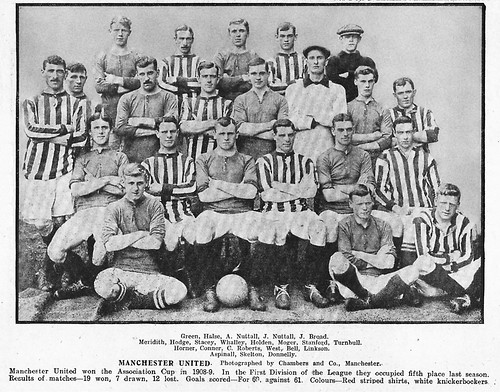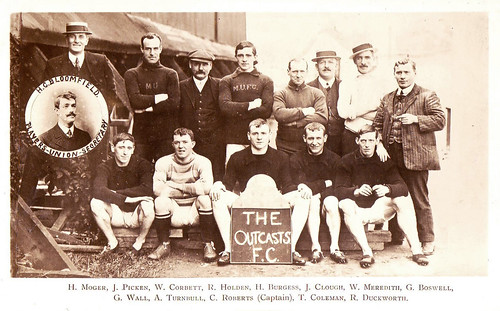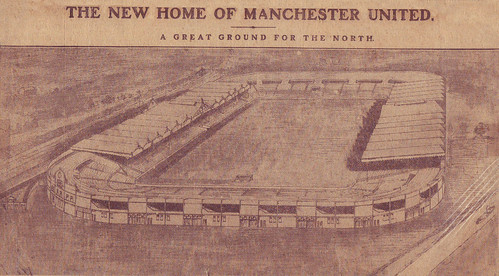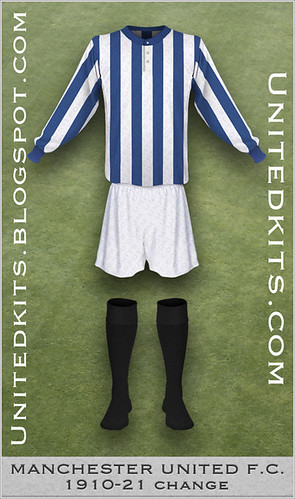United's FA Cup triumph was almost immediately followed by controversy. In the summer, the FA banned the entire team from taking part in the next season's competitions after they refused to abandon the Players Union - the founding of which they had been heavily involved in.
It had been at Harry Stafford's Imperial Hotel - a pub on Piccadilly of which he had been made manager by J H Davies - where Billy Meredith, Charlie Roberts and other players gathered for several meetings in 1907 that had led to the formation of the Union which the FA now perceived as a threat - so much so that they made all clubs write new contracts for their players that forbade them from becoming members. There was some resistance at first, but eventually all the league clubs buckled to their demands. All except for United. The FA did not humour their disobedience and took the measure of immediately banning all of the players from participating in the league and cup. They even closed the club's Bank Street ground to them, forcing the United players to practice over the other side of town at Fallowfield Stadium - a ground that had hosted the FA Cup Final in 1893 - and this was where the famous "Outcasts F.C." photograph was taken:
It had been at Harry Stafford's Imperial Hotel - a pub on Piccadilly of which he had been made manager by J H Davies - where Billy Meredith, Charlie Roberts and other players gathered for several meetings in 1907 that had led to the formation of the Union which the FA now perceived as a threat - so much so that they made all clubs write new contracts for their players that forbade them from becoming members. There was some resistance at first, but eventually all the league clubs buckled to their demands. All except for United. The FA did not humour their disobedience and took the measure of immediately banning all of the players from participating in the league and cup. They even closed the club's Bank Street ground to them, forcing the United players to practice over the other side of town at Fallowfield Stadium - a ground that had hosted the FA Cup Final in 1893 - and this was where the famous "Outcasts F.C." photograph was taken:
(This photo is part of the extensive Leslie Millman collection that can be found at www.flickr.com/photos/manchesterunitedman1/ and is used with full permission)
The players steadfast stance inspired other such as Everton's Tim Coleman (also on the above photograph) and eventually his teammates joined United in refusing to give up their Union. So did those from Middlesbrough, Newcastle, Sunderland and Liverpool - and from many other teams from across the country - until the FA was left with no choice but to back down and rescind the bans. The league was to go ahead after all, and with United as part of it as usual. For more information on this chapter of football history, see this article on the excellent Spartacus Educational site. Another article on that site reports that "When the Manchester United team played in the first match of the season on 1st September, 1909, they all wore AFPU arm-bands". Sadly I currently have no photographs from this match.
1909/10 was not to be an outstanding season for the Reds as the previous one had been - they finished 5th in the league and were knocked out of the cup in the first round by Burnley, whom United had beaten on the way to the previous season's final - but it was to be memorable as it marked the club's move to Old Trafford.
The move four miles west had been agreed back in 1908 and the plans were announced in March 1909, shortly before the club's appearance in the FA Cup Final. It was decided that Bank Street was not only unsuitable for use as a football ground with it's toxic fumes and waterlogged pitch, but that the team and their rising number of supporters had now outgrown it.
The famous architect of football grounds such as Ibrox to Goodison Park and White Hart Lane, Archibald Leitch, was hired to work on the new ground to be built on land owned by the chairman between the railway line and the canal on Warwick Road. It was originally designed to hold 100,000 spectators but was scaled back to 60,000 due to financial restraints.
Below is an artist's impression of the new United ground, complete with two covered stands - although only one would be covered when the ground opened (the current South Stand or Main Stand as it was known). The other stands also extend further back from the pitch than they did when the stadium was actually built:
1909/10 was not to be an outstanding season for the Reds as the previous one had been - they finished 5th in the league and were knocked out of the cup in the first round by Burnley, whom United had beaten on the way to the previous season's final - but it was to be memorable as it marked the club's move to Old Trafford.
The move four miles west had been agreed back in 1908 and the plans were announced in March 1909, shortly before the club's appearance in the FA Cup Final. It was decided that Bank Street was not only unsuitable for use as a football ground with it's toxic fumes and waterlogged pitch, but that the team and their rising number of supporters had now outgrown it.
The famous architect of football grounds such as Ibrox to Goodison Park and White Hart Lane, Archibald Leitch, was hired to work on the new ground to be built on land owned by the chairman between the railway line and the canal on Warwick Road. It was originally designed to hold 100,000 spectators but was scaled back to 60,000 due to financial restraints.
Below is an artist's impression of the new United ground, complete with two covered stands - although only one would be covered when the ground opened (the current South Stand or Main Stand as it was known). The other stands also extend further back from the pitch than they did when the stadium was actually built:
(This photo is part of the extensive Leslie Millman collection that can be found at www.flickr.com/photos/manchesterunitedman1/ and is used with full permission)
The last game at Bank Street was played on 22nd January against Spurs - a 5-0 victory. Only days later a storm blew one of the stands over causing extensive damage to the terraced houses opposite - United had chosen just the right time to leave Clayton.
The first game at Old Trafford took place on February 19th 1910, but was one to be forgotten - a 4-3 loss to Liverpool, with United squandering a 2-0 lead in front of over 50,000. Sandy Turnbull scored United's first ever goal at the ground. However, it was to be a rare home loss at that time, as United won all their remaining games at Old Trafford that season and all but one in the next, when they were again crowned League Champions after the title race went to the wire. In the end, United pipped Aston Villa to the post by a single point.
The first game at Old Trafford took place on February 19th 1910, but was one to be forgotten - a 4-3 loss to Liverpool, with United squandering a 2-0 lead in front of over 50,000. Sandy Turnbull scored United's first ever goal at the ground. However, it was to be a rare home loss at that time, as United won all their remaining games at Old Trafford that season and all but one in the next, when they were again crowned League Champions after the title race went to the wire. In the end, United pipped Aston Villa to the post by a single point.
The team before a practice match at the start of the 1910/11 season:

(This photo is part of the extensive Leslie Millman collection that can be found at www.flickr.com/photos/manchesterunitedman1/ and is used with full permission)

(This photo is part of the extensive Leslie Millman collection that can be found at www.flickr.com/photos/manchesterunitedman1/ and is used with full permission)
The text states United's colours as "red stripes", but this appears to be one of a number of inaccuracies in the text - several player's names are spelled incorrectly for example. It is fairly unlikely that any team would wear red as a home kit and red and white stripes as a change kit as they would clash, meaning another kit would have to be kept as third choice which was very uncommon at the time. Instead, it is far more likely to have been blue and white stripes like previous United change kits:




No comments:
Post a Comment